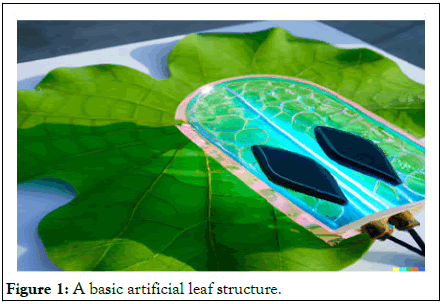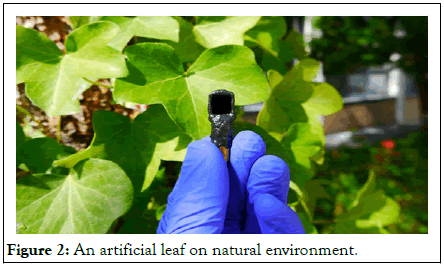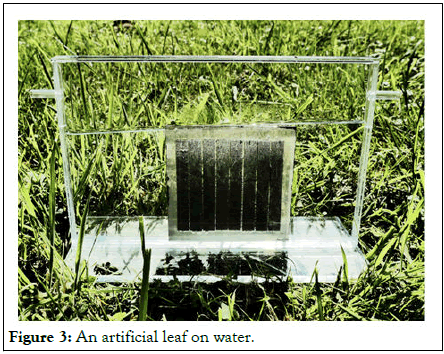
Journal of Fundamentals of Renewable Energy and Applications
Open Access
ISSN: 2090-4541
+44 1300 500008

ISSN: 2090-4541
+44 1300 500008
Research Article - (2023)Volume 13, Issue 2
The concept of artificial leaves, which mimic photosynthesis to generate energy from sunlight and water, holds great potential as a renewable energy source. However, several challenges must be addressed, including efficiency improvement, cost-effective materials and fabrication, durability and stability, and integration into energy systems and storage solutions. Addressing these challenges will be crucial for the widespread adoption of artificial leaves as a sustainable energy solution. In this research article, challenges in the development of such “artificial leaves” will be highlighted.
Artificial photosynthesis; Electrochemistry; Hydrogen production; Sustainable hydrogen; Water splitting
An "artificial leaf" is a man-made device that mimics the natural process of photosynthesis by using light energy to produce hydrogen gas [1]. This technology has gained attention as a promising solution for producing hydrogen in a sustainable and clean manner. Unlike traditional methods, artificial leaves use abundant resources such as water and sunlight, and do not emit harmful by-products. The technology involves the use of a semiconductor material that is coated with catalysts, which facilitate the splitting of water molecules into hydrogen and oxygen. When light energy is absorbed by the semiconductor material, it creates an electrical potential that drives the catalytic reaction, producing hydrogen gas [2].
Artificial leaves hold great potential for a wide range of applications, including fuel cells, power generation, and transportation. With the increasing demand for clean and renewable energy sources, artificial leaves provide a promising solution for producing hydrogen on a large scale, without relying on non-renewable resources or emitting harmful pollutants (Figure 1) [3].

Figure 1: A basic artificial leaf structure.
The background of an artificial leaf for hydrogen production is based on the principles of photo electrochemistry, which is the study of the interaction between light and matter [4]. The main goal of an artificial leaf is to provide a sustainable and renewable source of hydrogen, which can be used as a clean fuel for transportation, heating, and electricity generation [5].
The artificial leaf is designed to mimic the process of photosynthesis in plants, where light energy is used to convert carbon dioxide and water into glucose and oxygen [6]. In an artificial leaf, the photovoltaic cell absorbs sunlight and converts it into electrical energy, while the catalytic system splits water molecules into hydrogen and oxygen through a process called electrolysis [7].
The electrolysis of water can be represented by the following equation 1:
2H2O (l) → 2H2 (g) + O2 (g) (1)
Where;
H2O: Represents water, H2: Represents hydrogen gas, O2: Represents oxygen gas.
The hydrogen gas produced by the artificial leaf can be stored and used as a fuel [8]. The efficiency of the artificial leaf depends on several factors, including the materials used for the photovoltaic cell and the catalytic system, the design of the device, and the conditions under which the electrolysis reaction takes place [9]. In order to maximize the efficiency of the artificial leaf, researchers are working on developing new materials and designs that can improve the performance and stability of the device [10].
Overall, the artificial leaf has the potential to revolutionize the hydrogen fuel industry and provide a sustainable and renewable source of energy [11]. By using sunlight and water, the artificial leaf can reduce dependence on fossil fuels and decrease greenhouse gas emissions, contributing to a cleaner energy future [12].
In recent years, there have been significant advancements in the development of artificial leaves, including the use of advanced materials and improved catalysts [13]. However, there are still some challenges that need to be overcome, such as improving the efficiency of the technology, reducing costs, and developing scalable production methods [14]. Despite these challenges, the potential of artificial leaves for hydrogen production is significant, and their development is likely to play an important role in the transition to a clean and sustainable energy future [15].
Background and history
The history of artificial leaves for hydrogen production can be traced back to the late 1970’s, when researchers first started exploring the potential of Photoelectron Chemical Cells (PECs) for generating hydrogen from water using sunlight as a source of energy [16]. In PECs, light is absorbed by a semiconductor material, which creates electron-hole pairs as shown in Figure 2. The electrons are then transferred to the surface of the semiconductor, where they are used to reduce protons in the water to hydrogen gas. The holes, on the other hand, are used to oxidize water to oxygen [17].

Figure 2: An artificial leaf on natural environment.
The first artificial leaf was developed by John Bockris and his team at Texas A and M university in the late 1970’s, who demonstrated that PECs made of silicon could produce hydrogen from water in the presence of sunlight. Since then, a wide range of semiconductor materials have been explored for use in PECs, including silicon, titanium dioxide, and more recently, Metal-Organic Frameworks (MOFs) and grapheme [18]. The efficiency of artificial leaves for hydrogen production has improved over the years, with researchers developing new materials and designs to increase the yield of hydrogen from sunlight. For example, researchers have shown that the use of cocatalysts, such as Pt or Ir, can significantly improve the efficiency of PECs [19].
In recent years, there has been a growing interest in using artificial leaves for hydrogen production in off-grid and remote locations, where access to electricity is limited. Artificial leaves are seen as a promising technology for producing hydrogen in these areas, as they do not require an external power source, and can generate hydrogen from water and sunlight [20].
Overall, the history of artificial leaves for hydrogen production is a story of continued innovation and progress, with researchers continuously developing new materials, designs, and approaches to improve the efficiency and yield of hydrogen production from water and sunlight [21].
Principle of artificial leaf
The working principle of an artificial leaf involves the use of a semiconductor material, typically made of silicon or a similar material, coated with catalysts such as platinum or iridium [22]. The semiconductor absorbs light energy, which creates an electrical potential that drives the catalytic reaction to split water molecules into hydrogen and oxygen [23].
When light energy is absorbed by the semiconductor material, it excites electrons, which are then transferred to the catalysts [24]. The excited electrons reduce protons (hydrogen ions) in water to produce hydrogen gas, while the holes created in the semiconductor by the loss of electrons are used to oxidize water to produce oxygen gas. This can be described by the following equations 2 and 3:
Reduction: H+ + e- -> H2 (2)
Oxidation: 2H2O + 2e- -> O2 + 4H+ (3)
Combining the reduction and oxidation reactions, the overall reaction for the splitting of water molecules into hydrogen and oxygen can be expressed as follows (equation 4):
H2O + light energy -> H2+O2 (4)
In addition to the light energy, the reaction also requires an electrical potential to drive the transfer of electrons from the semiconductor to the catalysts. This potential is generated by the difference in energy between the valence and conduction bands of the semiconductor material. When light energy is absorbed by the semiconductor, it creates a difference in energy between the valence and conduction bands, providing the electrical potential required to drive the catalytic reaction as shown in Figure 3 [25].

Figure 3: An artificial leaf on water.
In summary, the working principle of an artificial leaf is based on the principles of photo catalysis and photo electrochemistry, utilizing the interaction between light energy, the semiconductor material, and the catalysts to produce hydrogen gas in a sustainable manner. The light energy absorbed by the semiconductor creates an electrical potential that drives the catalytic reaction to split water molecules into hydrogen and oxygen, producing hydrogen gas that can be collected and stored for later use as a clean and renewable energy source.
Challenges for artificial leaf
An artificial leaf is a device designed to mimic the natural process of photosynthesis by converting sunlight into chemical energy. Although the concept of an artificial leaf is promising, it still faces a number of challenges that must be overcome before it can become a viable alternative to conventional energy sources. In this research article, I will outline some of the key challenges facing artificial leaves.
Efficiency: Artificial leaves currently have low energy conversion efficiency compared to natural leaves. This limits their practical application and widespread use.
Stability: Artificial leaves need to be able to operate continuously for long periods without degradation or malfunction. This requires durable materials and stable catalysts that can withstand repeated cycles of energy conversion.
Cost: The current cost of producing artificial leaves is high, making them economically uncompetitive with traditional energy sources such as fossil fuels.
Scalability: Artificial leaves must be scalable to be economically viable and meet global energy demands. This requires the development of mass-production techniques and cost-effective materials.
Design: Artificial leaves must be designed in a way that is both efficient and practical for use in real-world applications. This requires a deep understanding of the underlying science and engineering principles, as well as consideration of factors such as size, weight, and stability.
Integration: Artificial leaves must be integrated with other energy storage and distribution systems to be practical and useful. This requires the development of new materials, catalysts, and systems that can work together seamlessly.
Environmental impact: Artificial leaves must be designed and manufactured in a way that minimizes their environmental impact. This requires consideration of factors such as the sustainability of materials, energy consumption during production, and potential for waste and pollution.
The development of artificial leaves presents a promising opportunity for the future of energy production. However, there are still significant challenges that must be overcome before artificial leaves can become a widespread, viable alternative to conventional energy sources. As the field continues to evolve and progress is made, it is likely that these challenges will be overcome and artificial leaves will play an increasingly important role in our energy mix.
We will conclude this brief assessment by highlighting the enormous potential that artificial leaves hold for advancing the advancement of the non-legacy world. With both rising populations and increasing levels of affluence in many developing economies, the demand for energy is also rising rapidly. Solar energy is essentially free. Hence the capture of solar energy and its conversion to storable fuels (such as hydrogen) in artificial leaves has excellent potential as a means by which this increasing energy demand can be met in a sustainable and environmentally-friendly manner. We hope that this research article will inspire others, especially those in the non-legacy world, to develop new artificial leaf devices that meet the needs and aspirations of their societies.
No data was used for the research described in the article.
The authors declare no conflict of interest.
The present work has been completed with the support of the Clean Energy Research Lab (CERL), COMSATS university Islamabad, Lahore campus, and the university of Lahore, Pakistan.
[Crossref] [Google Scholar] [Pubmed]
[Crossref] [Google Scholar] [Pubmed]
[Crossref] [Google Scholar] [Pubmed]
[Crossref] [Google Scholar] [Pubmed]
[Crossref] [Google Scholar] [Pubmed]
[Crossref] [Google Scholar] [Pubmed]
[Crossref] [Google Scholar] [Pubmed]
[Crossref] [Google Scholar] [Pubmed]
[Crossref] [Google Scholar] [Pubmed]
[Crossref] [Google Scholar] [Pubmed]
[Crossref] [Google Scholar] [Pubmed]
[Crossref] [Google Scholar] [Pubmed]
[Crossref] [Google Scholar] [Pubmed]
[Crossref] [Google Scholar] [Pubmed]
Citation: Rahman MU, Ahmad Z (2023) Future Challenges for an Artificial Leaf for Hydrogen Production. J Fundam Renewable Energy Appl. 13:308.
Received: 30-Jan-2023, Manuscript No. JFRA-23-21623; Editor assigned: 02-Feb-2023, Pre QC No. JFRA-23-21623 (PQ); Reviewed: 16-Feb-2023, QC No. JFRA-23-21623; Revised: 18-Apr-2023, Manuscript No. JFRA-23-21623 (R); Published: 25-Apr-2023 , DOI: 10.35248/2090-4541.23.13.308
Copyright: © 2023 Rahman MU, et al. This is an open-access article distributed under the terms of the Creative Commons Attribution License, which permits unrestricted use, distribution, and reproduction in any medium, provided the original author and source are credited.